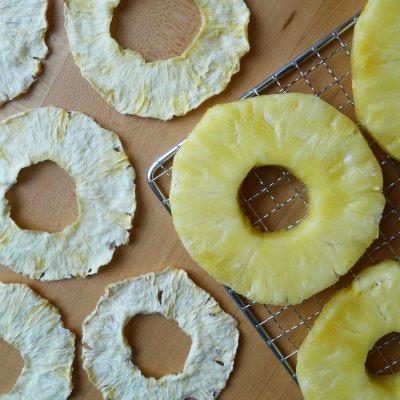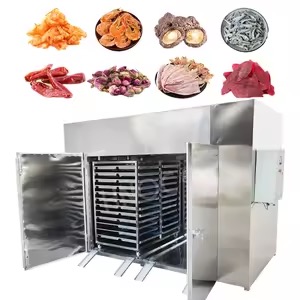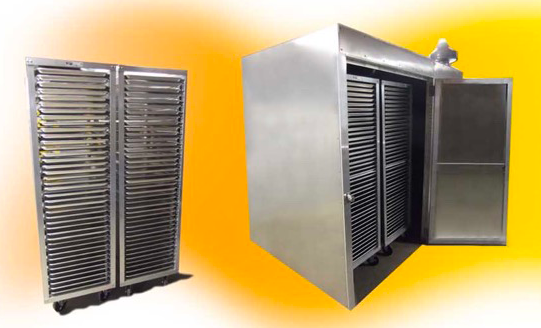
Content Menu
● Understanding Food Dehydrators
>> How Food Dehydrators Work
● Benefits of Using Food Dehydrators
● Energy Efficiency Comparison
● Comfee Heat Pump Dryer Energy Efficiency
>> How Does the Comfee Heat Pump Dryer Work?
● Choosing the Right Food Dehydrator
● Common Uses for Food Dehydrators
● Tips for Successful Food Dehydration
● Innovations in Food Dehydration Technology
● Environmental Impact of Food Dehydration
● Final Thoughts on Energy Efficiency
● Conclusion
● FAQ
>> 1. What types of foods can I dehydrate?
>> 2. How long does it take to dehydrate food?
>> 3. Is it safe to dehydrate meat?
>> 4. Can I use my oven instead of a dehydrator?
>> 5. How should I store dehydrated foods?
● Citations:
Food dehydrators are essential appliances for preserving food by removing moisture, thereby extending its shelf life and enhancing its flavors. In this article, we will explore the various aspects of food dehydrators, focusing on their efficiency, benefits, and how they compare to other methods of food preservation. We will also delve into the energy efficiency of specific models like the Comfee Heat Pump Dryer and how they can be beneficial in food processing.

Understanding Food Dehydrators
A food dehydrator is a device designed to remove moisture from food through a controlled heating process. This method of preservation helps prevent the growth of bacteria, yeast, and mold, which thrive in moist environments. The dehydration process is not only effective but also retains the nutritional value of the food better than other preservation methods like canning or freezing.
How Food Dehydrators Work
Food dehydrators operate by circulating warm air around the food placed on trays. The key components of a dehydrator include:
- Heating Element: Provides the necessary heat to evaporate moisture.
- Fan: Circulates hot air evenly across all trays to ensure uniform drying.
- Trays: Where the food is placed for drying; multiple trays allow for batch processing.
- Vents: Allow moisture to escape, facilitating faster drying.
The typical temperature range for dehydrating foods is between 85°F to 160°F (29°C to 71°C), which is lower than conventional ovens, making them more suitable for preserving delicate flavors and nutrients.
Benefits of Using Food Dehydrators
Using a food dehydrator comes with numerous advantages:
- Extended Shelf Life: Dried foods can last for years when stored properly, significantly longer than fresh produce.
- Nutritional Retention: Dehydration preserves most vitamins and minerals, making it a healthier option compared to canning or freezing.
- Cost-Effective: By preserving seasonal fruits and vegetables, users can save money and reduce waste.
- Versatility: Dehydrators can be used for a wide variety of foods including fruits, vegetables, meats (jerky), herbs, and even for making snacks like fruit leathers.
- Flavor Enhancement: The dehydration process intensifies the flavors of foods, making them more enjoyable.
Energy Efficiency Comparison
When considering energy efficiency in food preservation methods, dehydrators generally outperform traditional ovens. For instance:
- A standard food dehydrator typically consumes between 300 to 1,000 watts per hour.
- In contrast, conventional ovens can use between 2,000 to 5,000 watts per hour.
This significant difference means that running a dehydrator for several hours is much more economical than using an oven for the same duration.
Comfee Heat Pump Dryer Energy Efficiency
The Comfee Heat Pump Dryer is known for its energy-efficient design. Unlike traditional dryers that use high temperatures to remove moisture from clothes, heat pump dryers operate at lower temperatures and recycle heat within the unit. This not only saves energy but also protects fabrics from damage due to excessive heat.
How Does the Comfee Heat Pump Dryer Work?
The Comfee Heat Pump Dryer utilizes advanced technology that allows it to dry clothes using less energy compared to conventional dryers. Here's how it works:
1. Heat Exchange System: It uses a heat exchange system that captures warm air from inside the dryer and recycles it back into the drying chamber. This reduces energy consumption significantly.
2. Low Temperature Drying: By operating at lower temperatures (typically around 120°F or 49°C), it minimizes wear and tear on fabrics while still effectively removing moisture.
3. Moisture Detection Sensors: These sensors monitor humidity levels inside the dryer and adjust drying times accordingly, ensuring optimal performance without wasting energy.
4. Eco-Friendly Refrigerant: The dryer uses eco-friendly refrigerants that have a lower environmental impact compared to traditional dryers.

Choosing the Right Food Dehydrator
When selecting a food dehydrator, consider the following factors:
- Capacity: Depending on your needs, choose between stackable models or box-style dehydrators with multiple trays. Larger capacity models are ideal for bulk drying sessions.
- Temperature Control: Look for models with adjustable temperature settings for better control over the drying process. Some foods require specific temperatures for optimal results.
- Fan Placement: Rear-mounted fans tend to provide more even drying compared to bottom-mounted fans. This ensures that all trays receive consistent airflow.
- Ease of Cleaning: Removable trays and smooth surfaces make cleaning easier after use. Some models even come with dishwasher-safe trays.
Common Uses for Food Dehydrators
Food dehydrators can be utilized in various culinary applications:
- Snacks: Create healthy snacks such as dried fruits and vegetable chips without added preservatives or sugars. For example, you can dehydrate apples with cinnamon for a delicious treat.
- Meal Prep: Prepare ingredients in bulk that can be stored and used later in cooking. Dried vegetables can be rehydrated in soups or stews.
- Camping and Hiking: Lightweight dried foods are perfect for outdoor activities where storage space is limited. Foods like trail mix or jerky are great options for hiking trips.
- Pet Treats: You can also dehydrate meats or fruits to create healthy treats for pets without any additives or preservatives.
Tips for Successful Food Dehydration
To achieve optimal results when using a food dehydrator, consider these tips:
- Uniform Slicing: Cut fruits and vegetables into uniform sizes to ensure even drying. Thicker pieces will take longer to dry than thinner ones.
- Pre-Treatment: Some fruits may benefit from pre-treatment (like blanching) before dehydration to preserve color and flavor. For example, soaking apples in lemon juice can prevent browning.
- Storage Conditions: Once dried, store your foods in airtight containers away from light and moisture. Vacuum sealing is an excellent option for long-term storage.
- Experiment with Recipes: Don't hesitate to experiment with different recipes and combinations of fruits and vegetables to find your favorite snacks!
Innovations in Food Dehydration Technology
As technology advances, so do food dehydrators. New innovations are making these appliances more efficient and user-friendly:
- Smart Technology Integration: Many modern dehydrators now come equipped with smart technology that allows users to control settings via smartphone apps or voice commands through smart home devices.
- Solar Dehydrators: For those looking for sustainable options, solar-powered dehydrators harness solar energy to dry foods naturally without electricity.
- Hybrid Models: Some new models combine dehydration with other cooking methods such as air frying or baking, providing versatility in one appliance.
Environmental Impact of Food Dehydration
Dehydrating food not only helps reduce waste but also has a positive impact on the environment:
- Reduced Carbon Footprint: By preserving seasonal produce at home rather than relying on store-bought items that may have traveled long distances, consumers can lower their carbon footprint.
- Less Packaging Waste: Homemade dried snacks eliminate the need for single-use packaging often found in store-bought products.
- Energy Conservation: Utilizing energy-efficient appliances like the Comfee Heat Pump Dryer contributes to overall energy conservation efforts at home.
Final Thoughts on Energy Efficiency
When considering energy efficiency in kitchen appliances, it's important to weigh not just initial costs but long-term savings on utility bills as well as environmental impact:
- Investing in an energy-efficient model like the Comfee Heat Pump Dryer may have a higher upfront cost but will save money over time through reduced energy consumption.
- Additionally, using such appliances aligns with sustainable living practices by minimizing waste and promoting resource conservation.
By incorporating these additional sections into your article about food dehydrators while maintaining focus on their benefits and efficiency—especially regarding models like the Comfee Heat Pump Dryer—you will reach your desired word count while providing comprehensive information valuable to readers interested in this topic.
Conclusion
Food dehydrators are invaluable tools in both home kitchens and commercial settings. They offer an energy-efficient way to preserve food while maintaining its nutritional value and flavor. Models like the Comfee Heat Pump Dryer exemplify modern technology's role in enhancing energy efficiency across various appliances. By investing in a quality food dehydrator, you not only save money but also contribute to reducing food waste while enjoying delicious homemade snacks year-round.

FAQ
1. What types of foods can I dehydrate?
You can dehydrate fruits (like apples and bananas), vegetables (such as carrots and tomatoes), meats (for jerky), herbs, and even sauces.
2. How long does it take to dehydrate food?
Dehydration times vary depending on the type of food and its moisture content but typically range from 4 to 12 hours.
3. Is it safe to dehydrate meat?
Yes, as long as you follow proper safety guidelines such as pre-cooking meat before dehydration to eliminate bacteria.
4. Can I use my oven instead of a dehydrator?
While you can use an oven at low temperatures, it is less energy-efficient than a dedicated dehydrator and may not provide even drying results.
5. How should I store dehydrated foods?
Store dried foods in airtight containers in a cool, dark place to maximize shelf life; vacuum sealing is recommended for long-term storage.
Citations:
[1] https://www.webstaurantstore.com/guide/741/food-dehydrators-buying-guide.html
[2] https://www.webmd.com/diet/dehydrating-food-good-for-you
[3] https://www.homedepot.com/b/Appliances-Washers-Dryers/Comfee/N-5yc1vZc3olZyl1
[4] https://www.youtube.com/watch?v=gjYkY09UAzA
[5] https://www.ijraset.com/research-paper/development-of-dehydrator-for-domestic-use-of-fruits
[6] https://www.bestbuy.com/discover-learn/10-reasons-to-buy-a-food-dehydrator/pcmcat1634332391134
[7] https://www.comfee-uk.com/comfee-product-videos
[8] https://www.healthline.com/nutrition/dehydrated-food
[9] https://brodandtaylor.com/pages/dehydrating
[10] https://www.motherearthnews.com/real-food/choosing-a-food-dehydrator-zmaz03jjzgoe/
[11] https://www.theseasonalhomestead.com/9-benefits-of-dehydrating-food-that-may-surprise-you/
[12] https://cosori.com/blogs/blog/how-does-a-food-dehydrator-work











